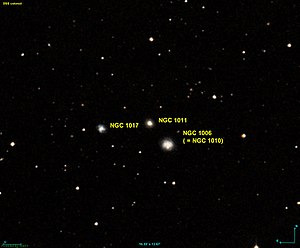NGC 1011
| Galaxy NGC 1011 |
|
|---|---|

|
|
| AladinLite | |
| Constellation | whale |
|
Position equinox : J2000.0 , epoch : J2000.0 |
|
| Right ascension | 02 h 37 m 38.9 s |
| declination | -11 ° 00 ′ 20 ″ |
| Appearance | |
| Morphological type | E0 |
| Brightness (visual) | 14.3 mag |
| Brightness (B-band) | 15.2 mag |
| Angular expansion | 0.6 ′ × 0.6 ′ |
| Surface brightness | 13.0 mag / arcmin² |
| Physical data | |
| Redshift | 0.015858 +/- 0.000057 |
| Radial velocity | 4754 +/- 17 km / s |
|
Stroke distance v rad / H 0 |
(211 ± 15) · 10 6 ly (64.8 ± 4.5) Mpc |
| history | |
| discovery | Édouard Stephan |
| Discovery date | November 21, 1876 |
| Catalog names | |
| NGC 1011 • PGC 9955 • MCG -02-07-045 • 2MASX J02373887-1100200 • HOLM 062B • LDCE 177 NED014 | |
NGC 1011 is a spiral galaxy of Hubble type Sa in the constellation Cetus south of the celestial equator . It is an estimated 211 million light years away from the Milky Way and has a diameter of around 35,000 ly.
In the same area of the sky are the galaxies NGC 1006 , NGC 1013 , NGC 1017 , NGC 1045 , among others .
The object was discovered on November 21, 1876 by Édouard Stephan .
